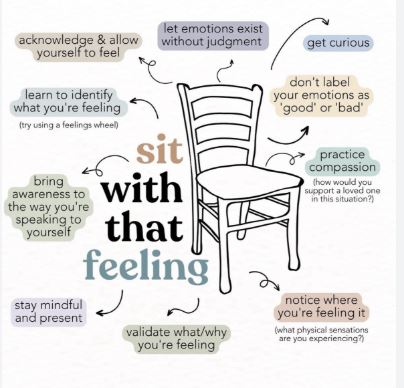By: Jaclyn Rink, MSCP, LLP
When you begin psychotherapy, one of the first things that you and your therapist will talk about will be developing proper coping skills. Coping skills are activities that you can use when emotions are feeling too big or overwhelming to help support overall regulation. They can be anything: deep breathing, progressive muscle relaxation, taking a nap, having a snack, going for a walk etc.
Being in this field for over 10 years, I can attest to the importance of building a toolbox of coping skills as a fundamental component of the therapeutic process (regardless of your age or presenting problem). However, what I’ve noticed over time is that some of my patients began using these coping skills to avoid their feelings or the situation. It’s almost as if these skills worked “too well”, and instead of helping clients to process their feelings, they accidentally began encouraging avoidance behaviors and strengthening their ability to ignore uncomfortable feelings.
For example, let’s say one of my teenage clients is struggling with anxiety. If every time she feels anxious, she turns on her Spotify and listens to music, she ends up avoiding the feeling of anxiety by turning her attention toward something else. This may help her to feel better in the moment, but long-term, her nervous system never really learns to tolerate or process feelings of anxiety. My patient is inadvertently teaching herself that she cannot rely on her own internal abilities to manage her emotions but instead requires an external factor in order to properly regulate. Because this relieved the anxiety in the moment, she will likely deem this coping skill as “effective” and rely on it over and over again in the future, robbing her nervous system of the opportunity to practice and become stronger at tolerating uncomfortable feelings.
One thing we so often forget about our feelings, is that they need to be felt. If we are always turning to coping skills, are we ever really feeling our emotions? Another fundamental component of therapy is learning how to “sit with” an emotion (vs. shooing it away or trying to avoid it). It is only when we genuinely acknowledge, feel, and listen to what our emotions are telling us, do they become fully processed, allowing us to more effectively let them go and move forward. By turning towards our emotions instead of away from them, our nervous system builds up its tolerance, furthering our ability to handle big emotions, while increasing our own self-confidence. So how does a person “sit with” an emotion?
1. Name it to tame it: Having clarity about what you are feeling reduces internal chaos and confusion. Consider referencing a feelings chart to help expand your emotional vocabulary and provide you with ideas of what emotion you may be experiencing. Be extra cautious when you are feeling anger, as it is often fundamentally rooted in a different emotion (e.g., anxiety, confusion, guilt, sadness, etc.) that is hiding underneath. Also remember that it is totally normal to feel two feelings at once, even if they are very opposite. Once you can label what you’re feeling, it becomes easier to understand (and then communicate if needed!)
2. Locate it in your body: Our bodies are constantly giving us insight into what’s happening internally, and often, emotions can get “stuck” in the body. Attempt to locate where in your body the emotion feels most prevalent or heavy. Your stomach? Your chest? Your jaw? Your hands? Attempt to channel some breath into the area you feel it most via visualization and breath work.
3. Make it Feel Welcome: Extend an invitation for your feeling to sit with you for a while. Allow it to be a part of your inner world without judgement or criticism. Create a nurturing environment that offers the support and space necessary to deeply feel. This may involve relaxing onto your couch, sitting down to journal, going for a leisurely stroll or even screaming into your pillow. These activities are not meant to distract, but to foster an environment that helps the emotion feel accepted and acknowledged. The goal is to stay mindful, present, and offer the feeling some space.
4. Get Curious About the Emotion: Inquire and investigate. Ask yourself some questions relating to the emotion, with the goal of sticking with it and further understanding it. What might this emotion be trying to tell you? What may have triggered it? Is this a familiar feeling? Try rating the feeling on a scale of 1-10. Try your best to describe how it feels. Does it feel heavy? Rapid? Sharp? What color is it? What might it look like if it was a painting, a monster, etc.?
5. Validate It: This is the most important step. Feelings need to know that you have received their message before they can dissipate. Validating your feelings means that you are establishing legitimacy, accuracy, and value for your experience. Any emotion is a natural part of the human experience. Affirm with yourself that what you are feeling is normal, even if it feels confusing or uncomfortable. Validation sounds something like, “It makes sense that I would be feeling this way.” “I’m allowed to feel angry.” “I give myself permission to feel this way.” If you really struggle with this, think about how you might speak to a friend if they came to you with the same experience or emotion. You would be far more likely to speak to them with compassion, kindness, and to remind them they are not crazy, and that their feelings make sense.
6. Release It: This step is all about somatic relief. Take a big sigh, stretch your spine, circle your arms, etc. Let out all the tears, shakes and tension you might be feeling.

Learning to sit with your feelings takes some practice, especially if you are used to denying or avoiding your feelings. If your emotions feel too overwhelming to sit with, please reach out to a trained mental health professional who can help you through the process.



